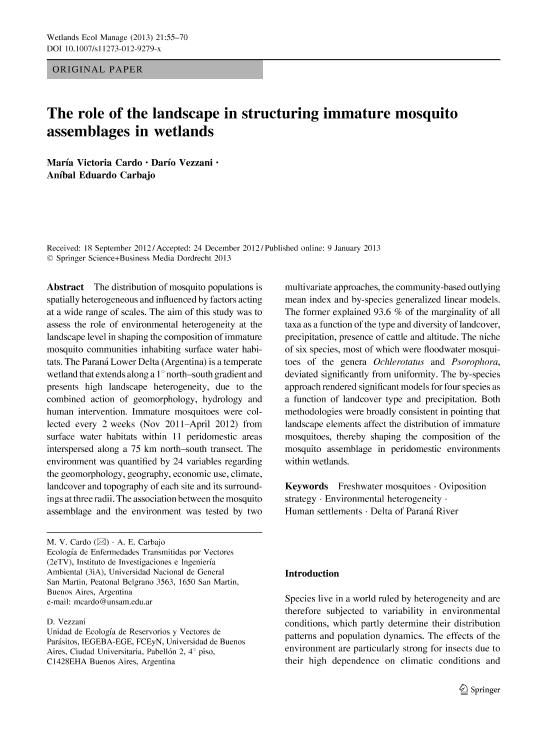Mostrar el registro sencillo del ítem
dc.contributor.author
Cardo, María Victoria

dc.contributor.author
Vezzani, Dario

dc.contributor.author
Carbajo, Anibal Eduardo

dc.date.available
2017-07-06T20:08:37Z
dc.date.issued
2013-02
dc.identifier.citation
Cardo, María Victoria; Vezzani, Dario; Carbajo, Anibal Eduardo; The role of the landscape in structuring immature mosquito assemblages in wetlands; Springer; Wetlands Ecology And Management; 21; 1; 2-2013; 55-70
dc.identifier.issn
0923-4861
dc.identifier.uri
http://hdl.handle.net/11336/19804
dc.description.abstract
The distribution of mosquito populations is spatially heterogeneous and influenced by factors acting at a wide range of scales. The aim of this study was to assess the role of environmental heterogeneity at the landscape level in shaping the composition of immature mosquito communities inhabiting surface water habitats. The Parana´ Lower Delta (Argentina) is a temperate wetland that extends along a 18 north–south gradient and presents high landscape heterogeneity, due to the combined action of geomorphology, hydrology and human intervention. Immature mosquitoes were collected every 2 weeks (Nov 2011–April 2012) from surface water habitats within 11 peridomestic areas interspersed along a 75 km north–south transect. The environment was quantified by 24 variables regarding the geomorphology, geography, economic use, climate, landcover and topography of each site and its surroundings at three radii. The association between the mosquito assemblage and the environment was tested by two multivariate approaches, the community-based outlying mean index and by-species generalized linear models. The former explained 93.6 % of the marginality of all taxa as a function of the type and diversity of landcover, precipitation, presence of cattle and altitude. The niche of six species, most of which were floodwater mosquitoes of the genera Ochlerotatus and Psorophora, deviated significantly from uniformity. The by-species approach rendered significant models for four species as a function of landcover type and precipitation. Both methodologies were broadly consistent in pointing that landscape elements affect the distribution of immature mosquitoes, thereby shaping the composition of the mosquito assemblage in peridomestic environments within wetlands.
dc.format
application/pdf
dc.language.iso
eng
dc.publisher
Springer

dc.rights
info:eu-repo/semantics/openAccess
dc.rights.uri
https://creativecommons.org/licenses/by-nc-sa/2.5/ar/
dc.subject
Ecologia de Paisajes
dc.subject
Mosquitos
dc.subject.classification
Ecología

dc.subject.classification
Ciencias Biológicas

dc.subject.classification
CIENCIAS NATURALES Y EXACTAS

dc.title
The role of the landscape in structuring immature mosquito assemblages in wetlands
dc.type
info:eu-repo/semantics/article
dc.type
info:ar-repo/semantics/artículo
dc.type
info:eu-repo/semantics/publishedVersion
dc.date.updated
2017-07-05T15:02:46Z
dc.identifier.eissn
1572-9834
dc.journal.volume
21
dc.journal.number
1
dc.journal.pagination
55-70
dc.journal.pais
Países Bajos

dc.journal.ciudad
Dordrecht
dc.description.fil
Fil: Cardo, María Victoria. Universidad Nacional de San Martín. Instituto de Investigación e Ingeniería Ambiental; Argentina. Consejo Nacional de Investigaciones Científicas y Técnicas; Argentina
dc.description.fil
Fil: Vezzani, Dario. Consejo Nacional de Investigaciones Científicas y Técnicas. Oficina de Coordinación Administrativa Ciudad Universitaria. Instituto de Ecología, Genética y Evolución de Buenos Aires. Universidad de Buenos Aires. Facultad de Ciencias Exactas y Naturales. Instituto de Ecología, Genética y Evolución de Buenos Aires; Argentina
dc.description.fil
Fil: Carbajo, Anibal Eduardo. Universidad Nacional de San Martín. Instituto de Investigación e Ingeniería Ambiental; Argentina. Consejo Nacional de Investigaciones Científicas y Técnicas; Argentina
dc.journal.title
Wetlands Ecology And Management

dc.relation.alternativeid
info:eu-repo/semantics/altIdentifier/doi/http://dx.doi.org/10.1007/s11273-012-9279-x
dc.relation.alternativeid
info:eu-repo/semantics/altIdentifier/url/https://link.springer.com/article/10.1007%2Fs11273-012-9279-x
Archivos asociados
